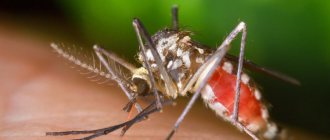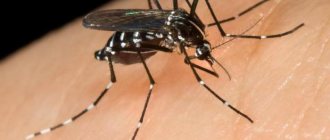Mosquitoes live on every continent of the world except Antarctica. These blood-sucking animals are carriers of various serious diseases - malaria, Zika virus, Dengue fever and others. They all have one thing in common - they are transmitted through blood. In this regard, a completely logical question arises: Is it possible to get AIDS from a mosquito? Despite the fact that during the period of laying eggs, female mosquitoes need to feed on the blood of people and animals, they are not carriers of the disease. It is impossible to become infected after a mosquito bite, even if it drank the blood of a virus carrier.
What diseases do bloodsuckers infect?
In the tropics, after being bitten by parasites, a huge number of people die from the infections they carry. Blood-sucking insects lead to severe damage to internal organs, paralysis, and death. Not all infections that tropical mosquitoes infect people have been treated with effective medications.
Mosquitoes carry the following diseases:
- Malaria. It is spread by female malaria mosquitoes, which are found not only in the tropics, but also in the south of Russia.
- Yellow fever. The disease is carried by mosquitoes living in Africa and Central America. No special therapeutic drugs have been developed against it yet. In severe cases, yellow fever causes the death of the patient.
Bloodsuckers also infect people:
- dengue fever;
- Japanese encephalitis;
- chikungunya.
People vacationing in tropical countries need to be careful: use mosquito repellents and seek medical help at the first symptoms of the disease. If the illness appeared after returning to Russia, then it is necessary to warn doctors about vacationing in the tropics.
The journal HIV Medicine published a systematic review by a group of British researchers, which summarized data on the risks of HIV transmission through bites and spitting. A total of 742 scientific articles covering these issues were analyzed over more than 30 years.
Let's start with spitting. Everything is clear here - such a transmission route for HIV has not been established, and researchers clearly exclude such a route. This is explained primarily by the properties of saliva, which effectively lyses viral particles.
In rare cases, bites have led to the transmission of HIV infection. Researchers are looking at confirmed cases as well as those that appear plausible. Here are some of them:
A man with primary central nervous system lymphoma bites an emergency worker a couple of weeks before his death. A copious amount of blood was recorded in the mouth of the biter. This happened in the mid-90s, and the person who was bitten received zidovudine monotherapy. Apparently not effective. Moreover, post-exposure therapy was also used for the bitten person in the form of zidovudine monotherapy, but on the 54th day from the bite, seroconversion was recorded. The viral load of the bitten person, as well as the presence of drug resistance mutations, have not been studied.
The CDC described a case of multiple deep bites on a 91-year-old man who received them while attempting to rob a female prostitute. The case dates back to 1995, seroconversion was recorded after 6 weeks, and the genetic relationship of the HIV strains was also confirmed.
A 44-year-old man was bitten in 2010 by his adopted HIV-positive son. As a result of the bite, the man lost his thumbnail. There is no clear evidence as to whether blood was present in the mouth of the person being bitten. The genetic relationship of the HIV strains has been confirmed. The biter had a viral load of 17,163 copies of HIV RNA per ml shortly after the incident.
There have also been two poorly documented cases of HIV transmission to children. In one case, described in a 2006 article, a three-year-old child was bitten by his father, who at the time had bleeding gums as well as extensive tooth decay. It is not known for certain whether this case is related to the transmission of HIV, or whether there were other undocumented episodes, since the man was diagnosed with HIV 3 years after the incident, after which he soon died. Phylogenetic analysis was not performed in this case.
Another case dates back to 1986. A child who received infected blood during cardiac surgery died due to toxoplasma lesions and HIV infection. After his death, family members were tested for HIV, and his brother was diagnosed with HIV infection. Six months earlier, the parents noted an incident in which a deceased brother had bitten another. It is unknown whether the transmission was related to one or another episode that was not noticed and described.
The article also presents a number of cases that the researchers classified as extremely doubtful.
Scientists indicate that the risks of HIV transmission through bites are extremely low, despite the fact that incidents involving bites occur relatively frequently. For example, in the United States, there are more than 600 cases of documented bites of police officers and emergency services personnel per year. A retrospective four-year review of only one emergency department in the UK found a rate of staff bites of at least one every three days. However, over many years of observation there are only isolated recorded and documented cases of HIV transmission. Most of them are characterized by the presence of a significant amount of blood in the mouth of the source of infection during the bite, as well as a significant volume and depth of damage.
Cresswell FV, Ellis J, Hartley J, Sabin CA, Orkin C, Churchill DR. A systematic review of the risk of HIV transmission through biting or spitting: implications for policy. HIV Med. 2022 Apr 23. PMID: 29687590.
Do mosquitoes carry HIV?
When AIDS began to spread, it was suggested that the immunodeficiency virus could be transmitted by blood-sucking insects. But further research did not confirm this information.
Mosquitoes cannot transmit HIV infection because the virus cannot live outside the human body. If an insect sucks the blood of a sick person, the viruses will immediately die in his stomach.
Some people fear that a mosquito that has drunk the blood of a sick person will inject it into a healthy person. This is not possible for the following reasons:
- Having sucked the blood of one person, the female mosquito does not fly to bite another. She hides in a secluded place and digests food for several days, and then looks for a pond to lay eggs.
- Even if we assume that after swallowing the blood of a sick person, a mosquito will immediately fly to another, it will not be able to inject blood into him. The bloodsucker's proboscis works in one direction. The insect injects its victim only saliva, in which the immunodeficiency virus cannot exist. In this way, it differs from malaria plasmodia, which pass from the insect’s stomach to its salivary glands, and then, together with saliva, enter the human body and cause disease.
Several studies have been conducted on the transmission of AIDS by blood-sucking insects, but they have not confirmed this possibility. The immunodeficiency virus spreads sexually, through the blood, and passes through the mother's placenta to the child. There are no other routes of transmission.
Features of HIV infection
Acquired immunodeficiency syndrome is a very complex and insidious disease. Even after contracting HIV, a person may not get sick for several years, but years later, the disease makes itself felt.
In this case, the patient develops new infections against the background of weakened immunity. As a result, AIDS can lead to irreversible processes, deadly illnesses and even oncology.
The immunodeficiency virus itself, once released into the external environment, is soon deactivated and completely dies.
Carrying out a blood test
High temperatures, severe frost, and disinfectants can kill it. In a drop of blood that is placed in a test tube, the virus lives for a couple of days.
The source of transmission of infection is only humans. In patients, the HIV virus is contained not only in the blood, but also in semen and other internal secretion fluids, including breast milk. Infection occurs precisely through contact with hazardous substances. At the same time, the virus lingers in other biological components, but not for long.
The disease triumphs in the new body if a dangerous infection gets directly onto mucous membranes, open wounds or into the bloodstream. It is impossible to get sick in any other way.
dispelling myths about the modes of transmission of AIDS
That is why it is not forbidden to shake hands and even kiss someone with AIDS.
Methods of infection
You should not think that AIDS is a legend created to frighten young people and aimed at ensuring that boys and girls lead a healthy lifestyle.
HIV is a real threat to humanity. You can protect yourself from it not only by arming yourself with knowledge, but also by getting used to taking the necessary precautions.
You should refrain from unprotected sex with unfamiliar partners. Today, according to medical statistics, 40% of AIDS cases are contracted this way.
Your future may depend on this choice
At the same time, women are at greater risk of infection than men due to the physiological characteristics of the body.
Infection can occur from a sick mother to her baby during childbirth or during breastfeeding.
Transmission of the disease from mother to baby
This route of transmission of the disease is possible only if the pregnant woman was not registered at the antenatal clinic or refused to carry out the necessary procedures while carrying the child. If you do everything to prevent it from becoming infected, in 99% of cases the baby is born healthy.
A drug addict's needle - this is how several people become infected when using syringes at the same time.
Infection through a syringe
However, in the modern world, when injection drugs have ceased to be relevant, and they have been replaced by “salts” and other synthetic substances, the route of transmission of AIDS through a drug addict’s needle is less and less identified by doctors.
Above are the main 3 types of transmission of this terrible disease. But there are a number of other important points that should be taken into account when protecting yourself from danger:
- Blood transfusion not under proper conditions.
- Carrying out operations in dubious clinics.
- Through contaminated instruments in nail and tattoo parlors.
You should not trust your health and life to dubious clinics and doctors. It is important to remember safety precautions.
The danger of mosquito bites
In Russia, cases of dengue or malaria are rare. The only danger mosquito bites pose is allergic reactions. They are caused by insect saliva, which contains substances that prevent blood clotting.
For most people, mosquito bites cause itching and small swelling. In babies under one year of age and in people with a strong tendency to allergies, blisters form, accompanied by itching and fever. In severe cases, anaphylactic shock is possible.
It is impossible to contract AIDS through a mosquito bite. If the parasite sucks the blood of a sick person, the virus will die in his stomach. Even if a person kills a mosquito with his bare hand, he is not in danger of getting sick.
↑ How likely is it to actually get infected with HIV through a condom?
The vast majority of modern condoms provide protection against infection with HIV and other STDs at the level of 97, 98 percent.
But nothing more! The remaining small percentage refers to those cases where the condom was either mechanically damaged in some way before or during direct sexual contact, or was not put on securely enough, or was not correctly selected for the size of the partner’s penis. Most modern condoms are more durable. And few people succeed in tearing or tearing them, not even by accident, but intentionally during sexual intercourse. This risk seems especially strange, given the intended use of a condom during sexual contact between people, which is primarily aimed at obtaining pleasure, simultaneously combined with the goal of minimizing the risk of possible transmission of a whole “bouquet” of STDs from partner to partner.
In any case, you need to use a condom carefully and responsibly in order to minimize the likelihood of unforeseen circumstances arising in any way related to the risk of not only transmitting an STD, but also becoming pregnant.
The strength of each batch of condoms is laboratory tested in production. For this purpose, there are special test models of male and female genital organs and other instruments that allow us to verify with a sufficient degree of reliability the strength and reliability of each batch of condoms for their future buyers.
The price, design, aromatic and other design of condoms are purely marketing decisions of manufacturers aimed at popularizing their own products to increase demand for them, as well as profits from their sales. No more. At the same time, you clearly should not give preference to the cheapest condoms, because they are highly likely to be less durable, reliable, and of less quality.
↑ More details about viral load and CD4 indicator
This CD4 indicator is most important when determining the grounds for starting and stopping prophylaxis for opportunistic diseases, as well as for assessing the degree of urgency of antiretroviral therapy.
At the same time, due to the widespread use of antiretroviral therapy for patients diagnosed with HIV, regardless of viral load indicators and available CD4 lymphocyte counts, additional determination of the CD4 index along with viral load before starting antiretroviral therapy is not considered necessary.
Among patients with chronically drug-supported suppression of the viral load and partial restoration of their immune system due to completion of a prescribed course of antiretroviral therapy, the CD4 lymphocyte count indicator turns out to be of little information.
↑ Drugs for HIV/AIDS and side effects from them
In most cases, side effects from taking recommended medications are minimal. But a person who seeks help from a doctor already at the 4th stage of the disease, which is very common in our country, with a CD score of less than 200 due to the depression of his immune system, which persists while taking medications, may develop the so-called restored syndrome. immune system. At the same time, exacerbations of certain diseases may develop, including candidiasis. In such cases, patients are prescribed symptomatic treatment. In the process of gradually getting used to the prescribed therapy, the human body begins to gradually recover to its previous level. Therefore, it is the timely and earliest possible detection of HIV infection that is so important.
↑ Viral load and CD4 count
The viral load, together with the number of CD4 T-lymphocytes, is an indicator of the response of the HIV-positive person to ongoing antiretroviral therapy and the current progression of HIV infection.
The viral load indicator turns out to be most useful and informative after the start of antiretroviral therapy.
Quantitative determination of the CD4 indicator is used to confirm the effectiveness of prescribed antiretroviral therapy. At the same time, determining the viral load allows you to obtain more accurate and informative data.
Determining the actual CD4 count as accurately as possible is most important and useful before initiating antiretroviral therapy. The lymphocyte count (CD4) provides more accurate information about the current state of the patient's immune system.











